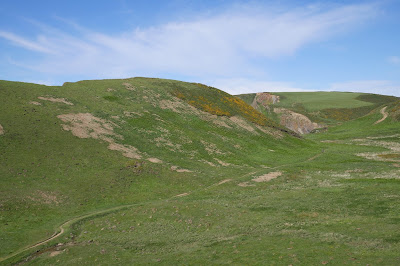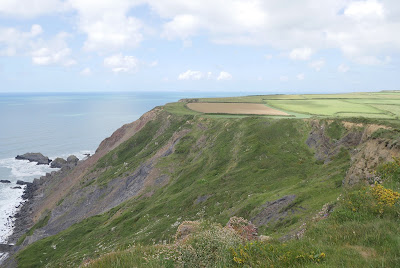View south from Hartland Quay
We started this walk from remote Hartland Quay with great views back to the south, albeit into the sun, and ahead to the north.
We
climbed steadily to reach the cliff top and walked along the grassy
path. There was a fine view out to sea towards Lundy island.
A bit further on there was a very photogenic ruin (of a tower according to the OS map). Off to the right, the
church of St Nectan (a new one!) could be seen across the grassy
plateau. Apparently the 130 foot tower is the highest in North Devon.
Soon there was a sharp descent to Dyers Lookout, with an attractive valley coming in from the landward side.
Hard
on the heels of the corresponding ascent was a further sharp descent to
Blegberry Beach, with of course another climb afterwards.
Next up was the rocky Damehole Point. Inland,
a long and rather lovely valley ran behind the coastal cliffs. This was
a bit unusual – we have seen any amount of valleys running inland at
right angles to the sea.
Before long we had our first views of the lighthouse at Hartland Point. It was opened in 1874 and like so many is now automated.
We passed behind it and headed towards the radar dome on the top of a red sandstone cliff above Barley Bay. It was erected in 1994 and is used
for air traffic control.
We continued along the cliff top path to Shipload Bay ...
... where we turned inland to reach East Titchberry Farm with its old Malt House clearly in need of some care and attention.
Conditions: bright and sunny.
Distance: 4 miles.
Map: Explorer 126 (Clovelly & Hartland)
Grading: Strenuous.
Grading: Strenuous.
Rating: Five stars.

















































